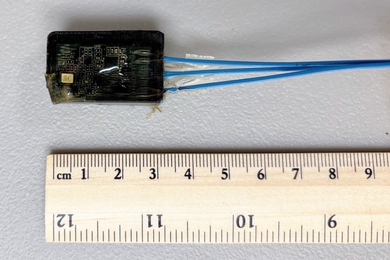Marine invasive species pose a major and expanding threat to global coastal ecosystems. Once introduced, these species are extremely difficult — often impossible — to eradicate. At the MIT Sea Grant College Program, undergraduate Michelle Slosberg has developed a geographically referenced risk-assessment method to predict sources of marine invasive species in the coastal waters of the northeastern United States and their potential to spread throughout the region.
Slosberg's research is part of an ongoing commitment at MIT Sea Grant to raise public awareness and provide approaches to prevent and mitigate the spread of marine invaders. "Although it is nearly impossible to predict which species are likely to invade," notes Judith Pederson, advisory leader and regional project coordinator at MIT Sea Grant, "we seek to identify high-risk sources and share this information with decision makers and residents of coastal areas."
Slosberg, working under the supervision of Pederson, identified countries where eight species of invaders are present and evaluated the likelihood that they would arrive in New England. The method integrates environmental factors, life-history information and shipping records to predict the spread of introduced species, and can be used to alert managers of coastal areas to potential invasive species.
Slosberg downloaded publicly available ship-arrival and ballast-water data from the National Ballast Information Clearinghouse for the last seven years (January 2004 to March 2011). She then sorted and summarized the data based on the origin and destination/discharge port of the ships and their ballast water. She further summarized this information by ecoregion, which is a method of dividing the world's coasts into ecologically delineated regions. For each ecoregion she calculated a risk value, based on the number of ships from the ecoregion and the amount of ballast water sourced there. All of the ecoregion data was input into ArcGIS, a program for visualizing geographic data, to understand how the risk was distributed geographically.
For each species in the study, Slosberg conducted a review of the literature to determine its current geographic range. In the ecoregions where the species was already present, the geographic-risk values were added to determine a new value, species risk. She then compared the species-risk values to determine which species were most likely to spread in the northeast United States.
Of the eight species studied, C. lepadiformis, a light bulb tunicate, and H. japonica, a Pacific alga, were found to be most likely to spread throughout the northeastern United States as a result of shipping. The riskiest sources of ships were the Carolinian region along the coast of the southeastern United States and Europe's North Sea. These and additional findings will appear in Slosberg's end-of-summer final report and will be distributed to marine invasive-species researchers throughout the U.S. northeast region.
When asked about the impact of this summer internship on her studies and career plans, Slosberg replied, "As a student at MIT, it's easy to lose context of the bigger picture, but my research at MIT Sea Grant has helped me see the relationship between my interest in studying invasive species and the analytical skills I've learned studying environmental science." Slosberg is at MIT Sea Grant under the auspices of MIT's Undergraduate Research Opportunities Program (UROP). Part of the class of 2012, she is majoring in earth, atmospheric and planetary sciences with a focus in environmental science. In addition to her work at MIT Sea Grant, Michelle is conducting undergraduate thesis research on long-term erosion rates on the island of Kaua'i. After receiving her SB, Michelle hopes to pursue a career in land conservation and stewardship.
Slosberg's research is part of an ongoing commitment at MIT Sea Grant to raise public awareness and provide approaches to prevent and mitigate the spread of marine invaders. "Although it is nearly impossible to predict which species are likely to invade," notes Judith Pederson, advisory leader and regional project coordinator at MIT Sea Grant, "we seek to identify high-risk sources and share this information with decision makers and residents of coastal areas."
Slosberg, working under the supervision of Pederson, identified countries where eight species of invaders are present and evaluated the likelihood that they would arrive in New England. The method integrates environmental factors, life-history information and shipping records to predict the spread of introduced species, and can be used to alert managers of coastal areas to potential invasive species.
Slosberg downloaded publicly available ship-arrival and ballast-water data from the National Ballast Information Clearinghouse for the last seven years (January 2004 to March 2011). She then sorted and summarized the data based on the origin and destination/discharge port of the ships and their ballast water. She further summarized this information by ecoregion, which is a method of dividing the world's coasts into ecologically delineated regions. For each ecoregion she calculated a risk value, based on the number of ships from the ecoregion and the amount of ballast water sourced there. All of the ecoregion data was input into ArcGIS, a program for visualizing geographic data, to understand how the risk was distributed geographically.
For each species in the study, Slosberg conducted a review of the literature to determine its current geographic range. In the ecoregions where the species was already present, the geographic-risk values were added to determine a new value, species risk. She then compared the species-risk values to determine which species were most likely to spread in the northeast United States.
Of the eight species studied, C. lepadiformis, a light bulb tunicate, and H. japonica, a Pacific alga, were found to be most likely to spread throughout the northeastern United States as a result of shipping. The riskiest sources of ships were the Carolinian region along the coast of the southeastern United States and Europe's North Sea. These and additional findings will appear in Slosberg's end-of-summer final report and will be distributed to marine invasive-species researchers throughout the U.S. northeast region.
When asked about the impact of this summer internship on her studies and career plans, Slosberg replied, "As a student at MIT, it's easy to lose context of the bigger picture, but my research at MIT Sea Grant has helped me see the relationship between my interest in studying invasive species and the analytical skills I've learned studying environmental science." Slosberg is at MIT Sea Grant under the auspices of MIT's Undergraduate Research Opportunities Program (UROP). Part of the class of 2012, she is majoring in earth, atmospheric and planetary sciences with a focus in environmental science. In addition to her work at MIT Sea Grant, Michelle is conducting undergraduate thesis research on long-term erosion rates on the island of Kaua'i. After receiving her SB, Michelle hopes to pursue a career in land conservation and stewardship.
![This map indicates relative risk from ecoregions outside the northeastern United States, evenly weighting ballast water volume sourced from a region and number of ships from that region. Red represents the highest risk and yellow the lowest risk. Ecoregions in white did not source any ships with a destination in the northeast United States [Sources: Basemap: NOAA 2011; Ecoregions: Spalding 2007].](/sites/default/files/styles/news_article__image_gallery/public/images/201108/20110818153919-1_0.jpg?itok=3ebxhV2i)






